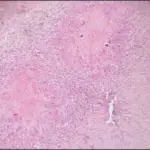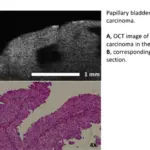Erythema nodosum is an acute, nodular, erythematous eruption typically limited to the lower legs extensor surfaces.
What is the Pathology of Erythema Nodosum?
The pathology of erythema nodosum is:
-Etiology: The cause of erythema nodosum is associated with infections tuberculosis, beta-hemolytic streptococcal infection, coccidioidomycosis.
-Genes involved: None.
-Pathogenesis: The sequence of events that lead to erythema nodosum is not well understood, believed to result from a delayed hypersensitivity response to antigens.
-Morphology: The morphology associated with erythema nodosum shows edema, fibrin exudation.
-Histology: The histology associated with erythema nodosum shows infiltration by, multinucleated giant cells, lymphocytes, eosinophils, histiocytes, and septal fibrosis.
How does Erythema Nodosum Present?
Patients with erythema nodosum are typically more common in females than males present at an age range of 18 to 34 years. The symptoms, features, and clinical findings associated with erythema nodosum include exquisitely tender, nodules, and erythematous plaques of the lower limbs.
How is Erythema Nodosum Diagnosed?
Erythema nodosum is diagnosed through the clinical presentation, and laboratory studies.
How is Erythema Nodosum Treated?
Erythema nodosum is treated through medical management of the symptoms, nonsteroidal anti-inflammatory drugs, wet compresses.
What is the Prognosis of Erythema Nodosum?
The prognosis of erythema nodosum is good.



